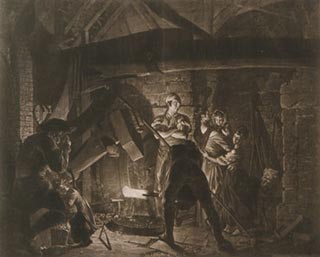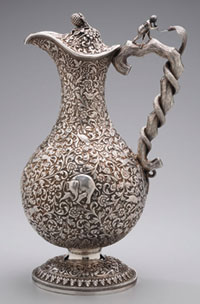Chazen features mezzotints, silver pieces in exhibits
Don’t let the big dig on University Avenue where the Peterson Building used to be keep you from visiting the Chazen Museum of Art. The museum is open for visitors, and two current exhibits there are worth a look: “Mezzotints, Prints of Darkness” and “Delight in Design: Indian Silver for the Raj.”

Mezzotint techniques allow artists to explore shadows, creating works with drama and mood. This print, “An Iron Forge,” is from 1778.
“Mezzotints, Prints of Darkness” surveys four centuries of mezzotints, a style of printmaking developed in the mid-1660s. Earlier printmaking techniques relied on hatching, cross-hatching and stippling to portray light and shadow. The results were limited to sharp lines, made with metal quills.
Artists, though, wanted to be able to reproduce all the shades available in between light and dark to create more expressive and nuanced works. Prints made by this new method were called manier noir, or dark manner, for the technique’s strength in rendering shadows. Today they are called mezzotints, from the Italian mezzo-tinto, meaning half-painted.
Mezzotints require extensive time and skill to make and are difficult to print. Despite these challenges, the technique is still popular with artists today because of its lovely mix of tone and texture.
The exhibit, taken from works held in the Chazen’s collection, traces the development of the technique from its earliest beginnings to its current application in contemporary works. Andrew Stevens, Chazen curator of prints, drawings and photographs, will deliver a gallery talk on the exhibit at 5:30 p.m. on Thursday, Oct. 1. “Mezzotints, Prints of Darkness” will be on display through Oct. 25.
“Delight in Design: Indian Silver for the Raj” presents more than 150 never-before-exhibited silver pieces produced during a period of British colonial rule in India, from 1858–1947. These objects were once standard issue in British households of a certain class, but are now symbols of a different way of life: fancy tea services, jugs for claret, goblets and ornamental bowls.

Indian artists created works for the British Raj, 1858–1947. This claret jug from 1890 has a snake for its handle.
Photo: Richard P. Goodbody, courtesy Wallach Art Gallery
But forget plain, aristocratic, stiff upper lips in the designs. The Indian silversmiths decorated the surfaces with ornate embellishments, often displaying distinctive regional Indian styles. Some artists created works that are heavily embossed. Others incorporated animals, such as a twisted snake for a handle or an elephant head for a spout. Some works are decorated with images of gods, or rural scenes with depictions of people carrying water or plowing fields with a backdrop of palm trees and huts.
Exhibition curator Vidya Dehijia will give a public lecture, “Whose Taste? Indian Silver for the Raj,” at 5:30 p.m. on Friday, Sept. 11, at the Chazen Museum. The lecture will be followed by a public reception at 6:30 p.m. Carnatic classical saxophonist Sumanth Swaminathan and Indian classical vocalist Vanitha Suresh will perform at the reception.
The Chazen has also scheduled eight sessions of artist demonstrations to accompany the exhibit. Attendees can see examples of the many metalworking techniques represented in the exhibition being created. The demonstrations will take place on Sept. 12, 13, 19, 20, 26 and 27; and on Oct. 3 and 4. The show runs through Oct. 4.
Visit http://www.chazen.wisc.edu for specific demonstration times and for more information on both exhibits.
And that construction going on next door to the museum? It’s part of the Chazen expansion project. When completed in the fall of 2011, it will add approximately 81,000 square feet to the museum, nearly doubling gallery space for the permanent collection and temporary exhibitions. New object study rooms, storage for artwork, a 160-seat auditorium for lectures and films, and a larger Museum Shop are also planned.




